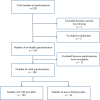Gynecologists' attitudes toward and use of complementary and integrative medicine approaches: results of a national survey in Germany
- PMID: 33201377
- PMCID: PMC7985114
- DOI: 10.1007/s00404-020-05869-9
Gynecologists' attitudes toward and use of complementary and integrative medicine approaches: results of a national survey in Germany
Abstract
Purpose: Despite patients' widespread use and acceptance of complementary and integrative medicine (IM), few data are available regarding health-care professionals' current implementation of it in clinical routine. A national survey was conducted to assess gynecologists' attitudes to and implementation of complementary and integrative treatment approaches.
Methods: The Working Group on Integrative Medicine of the German Society of Gynecological Oncology conducted an online survey in collaboration with the German Society of Gynecology and Obstetrics (DGGG) in July 2019. A 29-item survey was sent to all DGGG members by email.
Results: Questionnaires from 180 gynecologists were analyzed, of whom 61 were working office-based in private practice and 95 were employed in hospitals. Seventy percent stated that IM concepts are implemented in their routine clinical work. Most physicians reported using IM methods in gynecological oncology. The main indications for IM therapies were fatigue (n = 98), nausea and vomiting (n = 89), climacteric symptoms (n = 87), and sleep disturbances (n = 86). The most commonly recommended methods were exercise therapy (n = 86), mistletoe therapy (n = 78), and phytotherapy (n = 74). Gynecologists offering IM were more often female (P = 0.001), more often had qualifications in anthroposophic medicine (P = 0.005) or naturopathy (P = 0.019), and were more often based in large cities (P = 0.016).
Conclusions: There is strong interest in IM among gynecologists. The availability of evidence-based training in IM is increasing. Integrative therapy approaches are being implemented in clinical routine more and more, and integrative counseling services are present all over Germany. Efforts should focus on extending evidence-based knowledge of IM in both gynecology and gynecological oncology.
Keywords: Attitude; Breast cancer; Complementary and alternative medicine; Gynecologic oncology; Integrative medicine; Supportive care.
Conflict of interest statement
DG: research support: Greiner Bio-One GmbH; honoraria: Roche, ESOP, Genomic Health, Oncotype, PV: grant: Karl and Veronica Carstens Foundation; consulting role: Novartis; honoraria: Roche, Novartis, Celgene. CCH: honoraria from Roche and Novartis. SK: personal fees: Roche/Gentech, Genomic Health, Novartis, Amgen, Celgene, Daiichi Sankyo, Astra Zeneca, Somatex, MSD, Pfizer, PFM medical, Lilly, Sonoscape, nonfinancial support from Roche, Daiichi Sankyo, Sonoscape, outside the research submitted here. All other authors hereby declare that they had no conflicts of interest in preparing the present manuscript.
Figures
References
-
- Kalder M, Muller T, Fischer D, Muller A, Bader W, Beckmann MW, Brucker C, Hack CC, Hanf V, Hasenburg A, Hein A, Jud S, Kiechle M, Klein E, Paepke D, Rotmann A, Schutz F, Dobos G, Voiss P, Kummel S. A review of integrative medicine in gynaecological oncology. Geburtshilfe Frauenheilkd. 2016;76(2):150–155. doi: 10.1055/s-0042-100208. - DOI - PMC - PubMed
Publication types
MeSH terms
LinkOut - more resources
Full Text Sources
Medical



